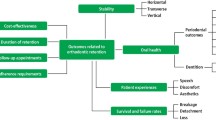Abstract
Design
A multi-centre randomised controlled study in 14 dental schools. This report is an interim analysis at 3 years.
Intervention
Patients were allocated to either the Removable dental prosthesis group (RPD)-109 patients or the no prosthesis group (SDA) -106 patients. Patients had to be older than 35 years with no molars in the study jaw. Follow-up visits were scheduled at 4 to 8 wks (baseline), at 6 months, and at 1, 2, 3, 4, and 5 yrs after treatment.
Outcome measure
Time to loss of first tooth following intervention or no intervention.
Results
81 patients received a RDP and 69 patients received no treatment in the end. This is a reduction of 26% and 35% respectively from the time when they were randomised to the two groups. Tooth loss occurred in 13 of the RDP group (16% of those who received the RDP, 12% of those allocated to the group at the start) with 5 of these being in the study jaw and 8 in the opposing jaw. Tooth loss occurred in 9 of the SDA group (13% of those who received SDA, 9% of those who were allocated to the group at the start) with 5 in the study jaw and 4 in the opposing jaw. The respective Kaplan-Meier survival rates at 38 months were 0.83 (95% CI: 0.74-0.91) in the RDP group and 0.86 (95% CI: 0.78-0.95) in the SDA group.
Conclusions
The difference in tooth loss at three years between patients treated with RDP and those not treated with RDP was not significant.
Similar content being viewed by others
Commentary
Clinicians can offer a variety of treatment opinions when confronted with partially dentate patients with the majority prescribed Removable Partial Dentures (RPDs). However, RPDs can be accompanied by a high biological price with increased risk of caries and periodontal disease reported in wearers.1,2 Evidence shows that the Shortened Dental Arch (SDA) offers an acceptable treatment alternative to provide patients with a cost effective, functional dentition with lower maintenance requirements.3, 4
This study reports on the interim results of a multi-centre randomised controlled clinical trial comparing tooth loss amongst patients with a SDA versus those provided with a RPD. 215 patients were recruited to the study from 14 dental schools throughout Germany. Patients were eligible to participate in the study if they were older than 35 years, in good general health and had all molar teeth missing in one arch. Participants were randomly allocated to each treatment arm with 106 patients offered no removable prosthesis (SDA) and 109 patients offered a RPD. The two treatment groups produced were similar in age profile and number of remaining natural teeth but the SDA group contained more female participants (54.7%) than the RPD group (45.0%).
A sample size calculation estimated that 70 patients were required per treatment arm to detect differences between the two groups. 81 patients were treated with a RPD and 69 received no RPD as part of the SDA group. 16 patients were lost to follow up whilst 12 discontinued treatment. All cases were analysed using the intention to treat principle. In total 22 patients lost teeth over the course of the trial; 13 patients from the RDP group and 9 from the SDA group. In the RPD group 9 teeth were lost due to endodontic complications, 3 due to caries and 1 due to fracture. In the SDA group 4 teeth were lost due to endodontic complications and 5 due to fracture. No statistically significant difference was found in tooth loss between the RPD or the SDA group.
The provision of RPDs as described in this trial would not be considered common prosthodontic practice within the United Kingdom or Ireland. Each of the RPDs were retained using precision attachments constructed as part of crowns or bridgework on abutment teeth rather than using clasps. These additional complex restorations may have accounted for some of the tooth loss described as “fracture” or “endodontic complications” rather than simply the presence or absence of a RPD. In addition, the authors do not make mention of which teeth were lost during the trial i.e. abutment teeth versus others in the arch.
The outcome measure described may have been too broad to measure over a three year interval. Other, more suitable, measures may have provided more telling results including caries incidence, periodontal attachment loss or tooth mobility. In addition, the teeth affected by disease should have been recorded as one would hypothesise that abutment teeth would be most at risk of disease attributable to a prosthesis. These results were not recorded in this paper. Overall, the authors have worked hard to achieve a representative sample of partially dentate patients but the prosthetic care described may make it impossible to apply their findings to the wider population.
References
Steele JG, Walls AW, Murray JJ . Partial dentures as an independent indicator of root caries risk in a group of older patients. Gerodontology 1997; 14: 67–74.
Zlataric DK, Celebic A, Valentic-Peruzovic M . The effect of removable partial dentures on periodontal health of abutment and non-abutment teeth. J Periodontol 2000; 73: 137–144.
Kayser AF . Shortened dental arches and oral function. J Oral Rehabil 1981; 8: 457–462.
Allen PF . How long should a shortened dental arch be? Dental Update 2008; 35: 454–459.
Author information
Authors and Affiliations
Additional information
Address for correspondence: Department of Prosthetic Dentistry, Technische Universität Dresden, University Hospital Carl Gustav Carus, Dental School, Fetscherstraße 74, 01307 Dresden, Germany. E-mail: michael.walter@uniklinikum-dresden.de
Walter MH, Weber A, Marré B et al. The randomized shortened dental arch study: tooth loss. J Dent Res 2010; 89: 818–822. Epub 2010 Apr 16.
Rights and permissions
About this article
Cite this article
McKenna, G. Do removable dental prosthesis have an impact on tooth loss?. Evid Based Dent 12, 14 (2011). https://doi.org/10.1038/sj.ebd.6400774
Published:
Issue Date:
DOI: https://doi.org/10.1038/sj.ebd.6400774



